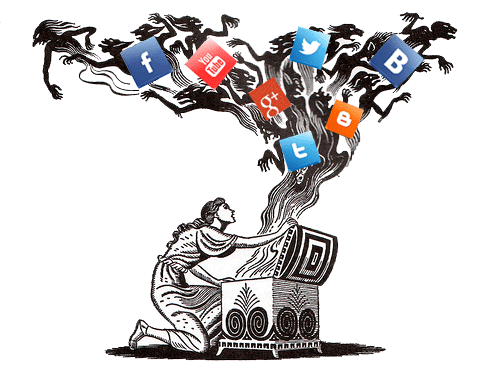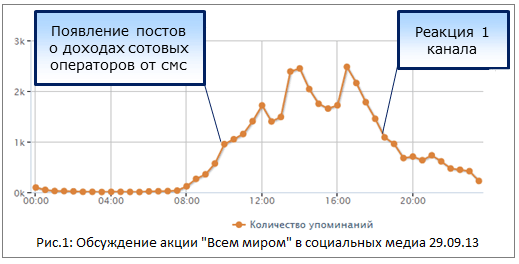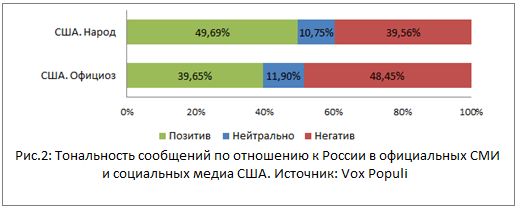Transformation of threats in the information space: from technological to social
Chekin is an invariable part of a business lunch, and VKontakte “is complicated with ..”. And are you still worried about the "big brother"? Why "spy" on the population if people themselves tell everything about themselves and loved ones? Is it enough to protect closed data from leaks today , when the analysis of open data will tell you an order of magnitude more? How to protect yourself from the “open data” themselves - throwing in inaccurate information, black PR, propaganda?
This article was written based on the report of our colleagues at the inter-regional conference on Information Security, held at the end of October 2013. The cases considered are based on real events, and all information for them was obtained from open sources.
Over the past year or two, the concept of “INFORMATION SECURITY” has expanded significantly: humanity has entered an era of excessive information openness , which has opened Pandora’s box of the latest information threats on the Web. In the article we discuss the new paradigm of "INFORMATION SECURITY" of the modern world.

Want to peek into Pandora's box? Then follow the cat.
To appreciate the graphomania of mankind, think about the scale: all over the world in the “classical” media 1 million documents are produced per day, while the generation of public user content (tweets, posts and comments on blogs, forums, social networks, services reviews) exceeds 1 billion per day, and the annual global increase in user content is 25%.
The development of this process in Russia is also impressive: we write 20 million messages per day (250 messages per second), and the monthly active audience (that is, those who leave at least one public message) exceeds 30 million people . The population of the city, region, and the whole country essentially becomes a unified information network for responding and disseminating information.
The familiar Paradigm of Information Security focuses on the PROTECTION of sensitive data. The new paradigm, firstly, is expanding due to open data, and secondly, it focuses on operational ANALYSIS and ADVANCE information attacks.
Technological (classic, basic) levels of information security - protection of classified information :
New, social levels of information threats - through analysis of open information :
We need a shield against the spear, against socio-informational threats — new tools of operational psychosociology, which we still have to come up with names for.

Below are a few cases showing approaches to identifying the most common informational threats at different social levels: from a person and a company to international conflicts.
Case refers to a recent action - the telethon “Whole World”, which hosted Channel One on September 29th. The purpose of the action was a powerful newsletter encouraging people to donate to flood victims in the Far East. Fundraising was carried out through SMS and electronic payment systems.
In general, the action was successful and was accompanied by active discussion on social networks: from September 26 to 30, 43,176 posts were published on the topic from 29,742 authors. However, it was the active discussion of the action, or rather, the lack of monitoring of this discussion that led to the problem, which did not allow to receive the maximum possible amount of donations.
In the morning of September 29, inaccurate information was published in social media that mobile operators would take half of the donations sent via SMS, and this information, picked up by popular Twitter readers, initiated an avalanche-like discussion on social networks: about 5% of all messages about the action are a discussion of this nuance. This has become one of the main reasons that kept people from sending SMS messages.
The response of Channel One appeared late, when inaccurate information was already widespread.

Thus, the social media information space has demonstrated its strength: the appearance of inaccurate information has negatively affected both the image of the action and the organizers, and the amount of funds raised.
The organizers of the action and the Big Three gave a detailed explanation in Vedomosti only the next day, which could not rectify the situation - time had already been lost.
Conclusions: The information flow in social media, accompanying public persons, companies and, especially, specialized campaigns, is an important element in influencing public opinion. Therefore, it is necessary to carry out real-time monitoring of the reaction , especially in the case of "social television", when viewers pour out emotions during the transmission, performance, competition, show, television debate.
CASE 2. WORLD (POLICY, LONG-TERM TRENDS) - IMPROVEMENT OF STEREOTYPES
The case was provoked by the Pew Research Center study, which was conducted in March-April 2013 and the results of which were "surprisingly successful" published on September 3 - right before the G20 meeting in St. Petersburg.
As part of the study, attitudes toward Russia were studied in 38 countries of the world, on the basis of which a conclusion was made about the negative perception of Russia in 36 (!) Countries. Only residents of Greece (63%) and South Korea (53%) are allegedly positively related to Russia. Cool, especially if you look at the methodology (1000 people were interviewed in each country) and the probability of an error reaching 7.7%.
The Russian Vox Populi Foundation conducted a “defensive” study: from September 9 to 13, over 770 thousand messages about Russia in the media and social media from 440 thousand authors from 231 countries were collected and analyzed. The study showed that in the individual attitude of people towards Russia, positive prevails, while in official sources (media, news agencies, officials), negative prevails. The analysis below shows the data (media and social media) of 74 thousand US residents who spoke for Russia on 4 days of September:

In addition, one cannot but pay attention to sharp differences in the emphasis on topics in relation to Russia in “officialdom” (official media, well-known political scientists and ex-officials) and among the people:

Conclusions:For public opinion, one can take stereotypes that the official media, news agencies or people interested in a certain “coloring” of events, persons, situations try to instill. The study of public opinion in social media becomes a powerful "shield" in opposing myths and stereotypes, blocking them as a weapon in international politics.
Intermediate results : only a couple of cases from the report are considered (if the readers are interested, we will give the rest in the next article), showing approaches to identifying the most common information threats. We suggest discussing methods of fighting in information wars and forestalling such threats in the comments. Just remember - everything you say can be used against you :)
This article was written based on the report of our colleagues at the inter-regional conference on Information Security, held at the end of October 2013. The cases considered are based on real events, and all information for them was obtained from open sources.
Over the past year or two, the concept of “INFORMATION SECURITY” has expanded significantly: humanity has entered an era of excessive information openness , which has opened Pandora’s box of the latest information threats on the Web. In the article we discuss the new paradigm of "INFORMATION SECURITY" of the modern world.

Want to peek into Pandora's box? Then follow the cat.
To appreciate the graphomania of mankind, think about the scale: all over the world in the “classical” media 1 million documents are produced per day, while the generation of public user content (tweets, posts and comments on blogs, forums, social networks, services reviews) exceeds 1 billion per day, and the annual global increase in user content is 25%.
The development of this process in Russia is also impressive: we write 20 million messages per day (250 messages per second), and the monthly active audience (that is, those who leave at least one public message) exceeds 30 million people . The population of the city, region, and the whole country essentially becomes a unified information network for responding and disseminating information.
INFORMATION THREATS: “CLASSICAL” AND NEW, SOCIAL
The familiar Paradigm of Information Security focuses on the PROTECTION of sensitive data. The new paradigm, firstly, is expanding due to open data, and secondly, it focuses on operational ANALYSIS and ADVANCE information attacks.
Technological (classic, basic) levels of information security - protection of classified information :
- Personal data (personal security);
- Corporate / group data (asset security);
- Regional / federal data (life safety and integrity).
New, social levels of information threats - through analysis of open information :
- Person / company - reputation threats of information attacks;
- Group - crowd control (from flash mobs to local riots and terrorist attacks);
- Region / country - promotion of ideas (opinion leaders, linguistic and confessional disunity, regional and federal elections);
- Worldwide - economy, short and medium term trends; politics, long-term trends (stereotyping, information warfare).
NEW THREATS DEMAND A NEW STRATEGY
We need a shield against the spear, against socio-informational threats — new tools of operational psychosociology, which we still have to come up with names for.

Below are a few cases showing approaches to identifying the most common informational threats at different social levels: from a person and a company to international conflicts.
CASE 1. PERSONNEL / COMPANY - REPUTATION THREATS: Throwing inaccurate information and reaction speed
Case refers to a recent action - the telethon “Whole World”, which hosted Channel One on September 29th. The purpose of the action was a powerful newsletter encouraging people to donate to flood victims in the Far East. Fundraising was carried out through SMS and electronic payment systems.
In general, the action was successful and was accompanied by active discussion on social networks: from September 26 to 30, 43,176 posts were published on the topic from 29,742 authors. However, it was the active discussion of the action, or rather, the lack of monitoring of this discussion that led to the problem, which did not allow to receive the maximum possible amount of donations.
In the morning of September 29, inaccurate information was published in social media that mobile operators would take half of the donations sent via SMS, and this information, picked up by popular Twitter readers, initiated an avalanche-like discussion on social networks: about 5% of all messages about the action are a discussion of this nuance. This has become one of the main reasons that kept people from sending SMS messages.
The response of Channel One appeared late, when inaccurate information was already widespread.

Thus, the social media information space has demonstrated its strength: the appearance of inaccurate information has negatively affected both the image of the action and the organizers, and the amount of funds raised.
The organizers of the action and the Big Three gave a detailed explanation in Vedomosti only the next day, which could not rectify the situation - time had already been lost.
Conclusions: The information flow in social media, accompanying public persons, companies and, especially, specialized campaigns, is an important element in influencing public opinion. Therefore, it is necessary to carry out real-time monitoring of the reaction , especially in the case of "social television", when viewers pour out emotions during the transmission, performance, competition, show, television debate.
CASE 2. WORLD (POLICY, LONG-TERM TRENDS) - IMPROVEMENT OF STEREOTYPES
Attitude to Russia in the world: “Pew Research” (USA) vs “Vox Populi” (Russia)
The case was provoked by the Pew Research Center study, which was conducted in March-April 2013 and the results of which were "surprisingly successful" published on September 3 - right before the G20 meeting in St. Petersburg.
As part of the study, attitudes toward Russia were studied in 38 countries of the world, on the basis of which a conclusion was made about the negative perception of Russia in 36 (!) Countries. Only residents of Greece (63%) and South Korea (53%) are allegedly positively related to Russia. Cool, especially if you look at the methodology (1000 people were interviewed in each country) and the probability of an error reaching 7.7%.
The Russian Vox Populi Foundation conducted a “defensive” study: from September 9 to 13, over 770 thousand messages about Russia in the media and social media from 440 thousand authors from 231 countries were collected and analyzed. The study showed that in the individual attitude of people towards Russia, positive prevails, while in official sources (media, news agencies, officials), negative prevails. The analysis below shows the data (media and social media) of 74 thousand US residents who spoke for Russia on 4 days of September:

In addition, one cannot but pay attention to sharp differences in the emphasis on topics in relation to Russia in “officialdom” (official media, well-known political scientists and ex-officials) and among the people:

Conclusions:For public opinion, one can take stereotypes that the official media, news agencies or people interested in a certain “coloring” of events, persons, situations try to instill. The study of public opinion in social media becomes a powerful "shield" in opposing myths and stereotypes, blocking them as a weapon in international politics.
Intermediate results : only a couple of cases from the report are considered (if the readers are interested, we will give the rest in the next article), showing approaches to identifying the most common information threats. We suggest discussing methods of fighting in information wars and forestalling such threats in the comments. Just remember - everything you say can be used against you :)
